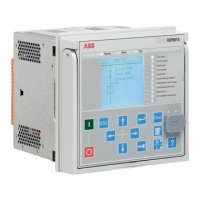SMVRCV
O:146|T:2,5|I:1
UL1
UL2
UL3
Uo
ULTVTR1
O:147|T:2,5|I:1
UL1
UL2
UL3
MINCB_OPEN
ALARM
WARNING
RESTVTR1
O:148|T:2,5|I:1
Uo ALARM
WARNING
ULTVTR1_ALARM
ULTVTR1_WARNING
RESTVTR1_ALARM
RESTVTR1_WARNING
GUID-B526E64B-2782-48C5-98EA-5F00375D01D9 V1 EN
Figure 46: Receiving all phase voltages and residual voltage using SMV
Synchrocheck function requires and uses only single analog phase voltage (UL1)
connected to ULTVTR2.
SMVRCV
O:146|T:2,5|I:1
UL1
UL2
UL3
Uo
ULTVTR2
O:147|T:2,5|I:2
UL1
MINCB_OPEN
ALARM
WARNING
ULTVTR2_ALARM
ULTVTR2_WARNING
GUID-47BC90E8-6B3F-4096-AC1D-381C8E1F7A28 V2 EN
Figure 47: Receiving line voltage for synchrocheck functionality using SMV
If only one phase (UL1) is connected between SMVRCV and
ULTVTR2, then VT connection parameter of the ULTVTR2 function
block needs to be set to “UL1” in the Parameter Setting tool in
PCM600 before writing the configuration to the IED.
ALARM and WARNING outputs are active during the configuration
writing. If VT connection type is set incorrectly, ULTVTR ALARM
and WARNING outputs are always active. In case of unsupported
configuration, SMV error is indicated.
The
WARNING output of TxTR should be connected in the SMV applications to
perform the necessary actions in case the SMV angle information is out of the
accuracy range. Depending on the protection function operation principle, inaccurate
angle information is also seen in the related protection function operation inaccuracy.
Additionally, the ALARM output of TxTR should be connected to ensure fail-safe
operation in all circumstances. The WARNING output is always internally active
whenever the ALARM output is active.
WARNING and ALARM information is internally propagated for the measurement
functions. Thus, measurement functions are able to update the measured value quality
information accordingly without any additional connections.
Section 6 1MRS757809 C
Process bus and IEEE 1588 time synchronization
70 REC615 and RER615
Engineering Guide

